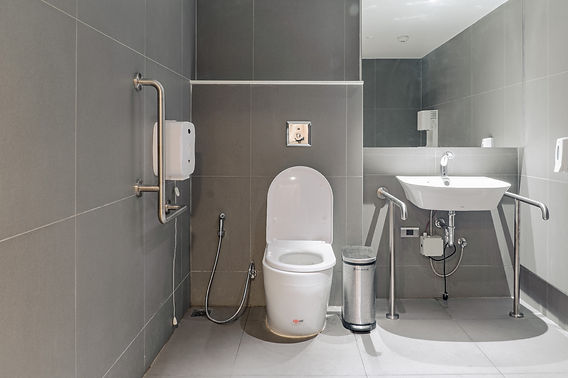The bathroom is one of the most frequently used areas in a home, and ensuring its safety is crucial. Among the various aspects of bathroom safety, bathroom flooring with texture safety plays a significant role. The right flooring can prevent slips and falls, providing peace of mind to homeowners. In this comprehensive guide, we’ll explore the different types of textured bathroom flooring options, their benefits, and how to choose the best one for your home.

Why Choose Textured Bathroom Flooring?
Textured bathroom flooring offers several advantages over smooth surfaces. The primary benefit is its slip-resistant nature, which reduces the risk of accidents, especially in a wet environment. Textured surfaces provide better grip, making them an ideal choice for families with children or elderly members. Additionally, these floors add a unique aesthetic appeal to your bathroom, enhancing its overall look.
Types of Textured Bathroom Flooring
There are various types of textured flooring options available for bathrooms. Each type comes with its own set of benefits and considerations. Let’s take a closer look at some popular choices:
Ceramic and Porcelain Tiles
Ceramic and porcelain tiles are popular due to their durability and water resistance. Textured versions of these tiles offer improved traction, making them a safe choice for bathrooms. They are available in a wide range of styles and colors, allowing you to customize the look of your bathroom.
Vinyl Flooring
Vinyl flooring is an affordable and versatile option. It comes in various textures that mimic the appearance of natural materials like wood or stone. Vinyl is water-resistant and easy to maintain, making it a practical choice for busy households.
Natural Stone
Natural stone flooring, such as slate or travertine, offers a unique and luxurious look. Textured stone surfaces provide excellent slip resistance. However, they require regular sealing to maintain their appearance and functionality.
Factors to Consider When Choosing Textured Bathroom Flooring
When selecting the right textured flooring for your bathroom, consider the following factors:
Water Resistance
Given the wet environment of a bathroom, water resistance is a crucial factor. Ensure the flooring material can withstand moisture without damage.
Durability
Choose a durable material that can handle the wear and tear of daily use. This is especially important in high-traffic bathrooms.
Maintenance
Consider the maintenance requirements of the flooring material. Some options, like natural stone, may require more upkeep than others.
Style and Aesthetics
Select a flooring style that complements your bathroom’s overall design and decor.
Installation Tips for Textured Bathroom Flooring
Proper installation is key to ensuring the safety and longevity of your bathroom flooring. Here are some tips to keep in mind:
Hire a Professional
Consider hiring a professional installer to ensure the job is done correctly. This is especially important for materials that require precise cutting and fitting, like tiles.
Prepare the Subfloor
Ensure the subfloor is clean, dry, and level before installation. This will help prevent any issues with the new flooring.
Use the Right Adhesive
Choose an adhesive that is suitable for your flooring material and the bathroom environment. This will help secure the flooring in place and prevent water damage.
Maintaining Textured Bathroom Flooring
Proper maintenance is essential to keep your textured bathroom flooring looking and functioning its best. Here are some maintenance tips:
Regular Cleaning
Clean the floor regularly to prevent dirt and grime buildup. Use a mild detergent and a soft brush to clean textured surfaces.
Seal Natural Stone
If you have natural stone flooring, apply a sealant regularly to protect it from moisture damage.
Inspect for Damage
Regularly inspect the flooring for any signs of damage, such as cracks or chips, and address them promptly to prevent further issues.
Enhancing Bathroom Safety with Additional Features
In addition to choosing the right flooring, consider incorporating other safety features into your bathroom design. [Bathroom waterproof mats](https://rebuildingtogethernb.org/bathroom-waterproof-mats-safety/) and childproof faucet covers are excellent additions for enhancing safety.
Install Grab Bars
Installing grab bars in key areas, such as near the shower or toilet, can provide additional support and prevent falls.
Use Non-slip Mats
Place non-slip mats in areas prone to water exposure, such as near the shower or bathtub. These mats provide extra traction and reduce the risk of slipping.
Ensure Proper Lighting
Good lighting is essential for bathroom safety. Ensure the room is well-lit to prevent accidents and make it easier to navigate.
For more information on bathroom safety features, consider checking out [this external resource](https://www.humancareny.com/blog/bathroom-safety-for-the-elderly) on bathroom safety for the elderly.

FAQ
What is the best textured flooring for bathrooms?
Ceramic and porcelain tiles are among the best options due to their durability, water resistance, and variety of textures.
How can I maintain textured bathroom flooring?
Regular cleaning and proper sealing (for natural stone) are key to maintaining textured bathroom flooring.
What are some additional bathroom safety features?
Consider installing grab bars, using non-slip mats, and ensuring proper lighting for enhanced safety.
This article contains affiliate links. We may earn a commission at no extra cost to you.

